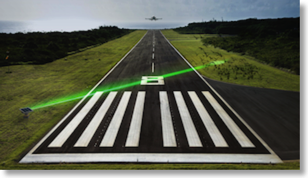Home
A comprehensive resource for safe and responsible laser use
Japan: Laser searchlight proposed to use QR codes to rescue hikers and climbers
The team, which is conducting the experiment at a campus in the western Japan city of Nara, has successfully scanned the two-dimensional code from a distance of about 300 meters and aims to put the system into practical use in the near future.
The code for the system measures about 11 centimeters (4.3 inches) on each side and is made from a retroreflective material. The print employs the same principle as that for reflecting road signs and can be scanned by a powerful laser searchlight.
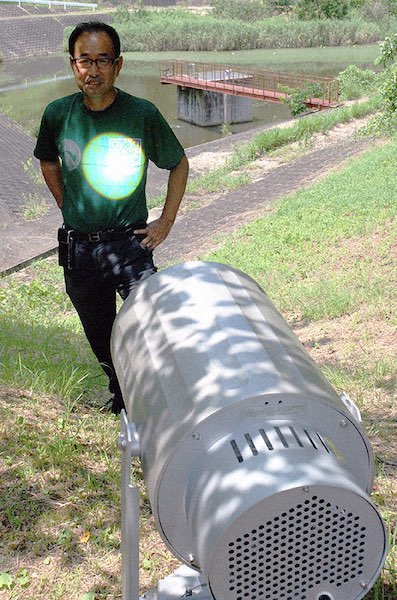
A laser searchlight lights up a QR code on professor Yoshinobu Maeda's shirt at a Kindai University campus in the city of Nara. (Mainichi/Yasuhiro Okawa)
In responding to an actual situation, the team works on the assumption that a large laser emitter will be loaded on a helicopter to scan the mountain surface. The machine can spot a QR code from the light reflected from the ground. It's possible to identify a disaster or accident victim if their personal information, such as name and sex, has been registered with the code.
The system is being developed by a team consisting of scientists at the Faculty of Science and Engineering, and the Faculty of Architecture at the university.
Team leader Yoshinobu Maeda, a professor with the Faculty of Science and Engineering, said, "The system is technically advanced to a level where it can be introduced. The problem is how we spread its use. It's necessary for many people who enter mountain areas to wear clothes with QR codes and for helicopters to be equipped with laser searchlights."
From The Mainichi
Canada: Laser used to help Parkinson's patients walk more steadily now available
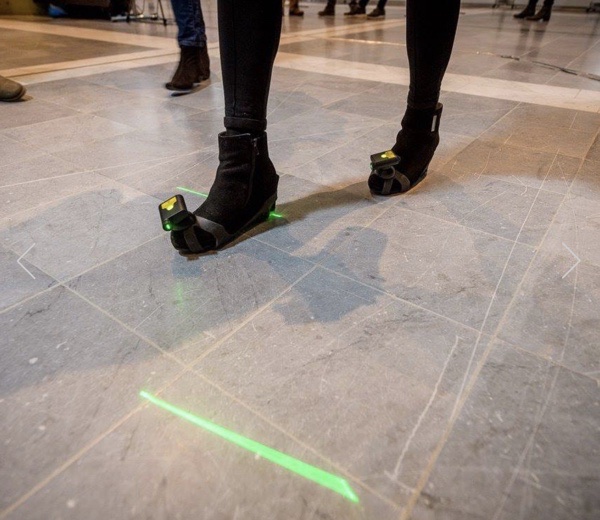
According to the manufacturer, "Path Finder is a shoe attachment that provides visual laser cues for patients suffering from Freezing of Gait (FoG), a symptom of Parkinson’s (PD) and other neurological disorders, severely impacting gait and quality of life. These visual laser cues are in the form of horizontal lines, prompting the individual to take steady steps with both feet, one after another. This hands-free device is meant for individuals with unsteady gait, and can be used to gain confidence, regain mobility, prevent falling and improve quality of life."
It uses a green Class 2 laser, meaning the light is considered safe for normal operation. According to LaserSafetyFacts.com's page on Class 2 lasers, "It normally would not harm an eye unless a person deliberately stared into the beam."
The idea for Path Finder came to inventor Lise Pape in 2014, after watching her father struggle with Parkinson's. She became aware that visual cues such as lighted canes had been used with some success to help trigger a normal step response. She started work on a prototype in 2014, and the product came to market in 2017.
It has won more than fifteen awards, including the AXA Health Tech and You Award in the UK in 2016 and Vodafone TechStarter in the UK in 2019.
Story from Digital Health with information from the Path Finder website and news blog.
UK: Animal lovers protest using lasers to scare away geese
The manager of Hall Place, the Bexley council, introduced the laser to reduce the number of geese.
According to a May 17 2019 news story, "The geese are said not to be hurt by the laser and perceive the approaching beam as a physical danger or predator-like presence and so disperse."
But members of the public and the Royal Society for the Prevention of Cruelty to Animals raised concerns. Some of these were about the safety of aiming laser light towards the animals. An RSPCA spokeswoman said: “As with humans, we would not support shining a laser directly into an animal’s eye."
Other concerns were about forcing the geese to leave their "home." One person who started a petition said "The laser shoots out this green light that gives a shock that tells them it is not safe… If we keep pushing them away, there will be nowhere for them to go."
From the Evening Standard
South Korea: Firefighter suggests how laser pointers can help in fighting fires
The net-like grid will make the surface contour visible.
eBay Korea hosts a contest for firefighters to find and then develop useful firefighting tools. Bethel also has submitted ideas for laser-projecting messages from the back of fire trucks onto streets. He said, “The laser pointers will display signs, such as ‘no entry’ or ‘this lane is occupied by a fire engine’. By doing so, it can help firefighters save time spent setting up a perimeter using traffic cones.”
From a July 16 2018 story in the Korea Times
US: Marines to buy 1,653 eye-safe laser dazzlers
- An infrared (1535nm) laser rangefinder determines the distance to a person or object. The closer the distance, the lower the laser power output.
- Near-field detection shuts off laser emission if a person or object is too close to the laser output aperture.
- A 3-axis gyroscope detects motion. If the Glare Recoil is suddenly moved, the laser shuts off until stability is resumed and an accurate determination of the distance to a person or object can be re-established: “This prevents hazardous irradiance in situations where Glare Recoil is moving faster than the laser rangefinder can detect objects and dose power output. This results in the prevention of eye hazard danger caused by rapid movement of the device (example: flagging) or improper situational awareness of the operator.”
With these technologies, the laser detects objects or people in the proximity of the beam and then self-adjusts the power output to maintain eye safety. The Nominal Ocular Hazard Distance is said to be 0 meters; the range is 10 feet to 10 miles.
Suggested uses include urban patrolling, cordon and search, crowd control, clearing facilities and security checkpoints.
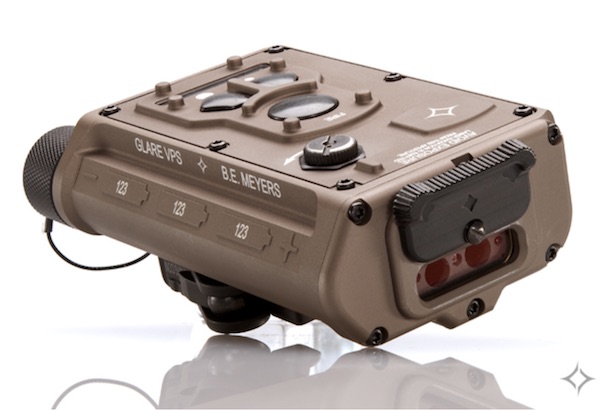
The Glare Recoil is about the size of a Walkman tape player at 5.5” x 3” x 2”. It can mount on a rifle or be handheld.
Meyers also sells a Class 1M “Glare Helios” which has an FDA variance allowing sales to U.S. local, state and federal law enforcement, and U.S. flagged vessels.
From Marine Corps Times, Soldier Systems, and B.E. Meyers. A video produced by the company goes into detail about the specifications and how the person/object detection works.
US: Low-cost malaria detector uses a laser pointer and a magnet
The portable device is about the size of a toaster. It “has been made simple enough to be used by everyone and is also compact and rugged so that it can be shipped worldwide.”
One of the principal researchers is working on making this commercially available.
Popular press account at CrazyEngineers.com. Scientific paper published May 21 2018: Rapid Diagnostic for Point-of-Care Malaria Screening, Samantha E. McBirney, Dongyu Chen, Alexis Scholtz, Hossein Ameri, and Andrea M. Armani, ACS Sensors Article ASAP, DOI: 10.1021/acssensors.8b00269
US: $8 billion space telescope aligned for shipping with $70 hardware store lasers
The container was 100 feet long and had to fit with a clearance of about six inches on each side.
In testing the container’s fit in the C-5C, engineers originally used cameras to line up the container within 1/2 inch of the aircraft centerline. However, the camera method did not work in practice.
So lead project engineer John Andersen suggested using laser guides from a local home repair store. One laser would shine along the centerline of the floor, the other would mark the centerline of the back of the shipping container. As Anderson explained, “So, for about $70, we bought the laser guides, set them up, and we were able to load the container perfectly by following the laser lines.”
He added, “I’m glad we came up with a cheap solution to load the container on the aircraft using the lasers. It didn’t cost thousands of dollars to do it or a lot of time.”
The space telescope is scheduled to be launched from French Guiana in 2019.
From the Dayton Daily News
New Zealand: Researcher considers drone-mounted lasers to burn weeds
He said a drone-mounted laser could take 2-3 hours to do a weed-killing job that would take a farmer 2-3 days.
Ghamkhar hopes to start testing the lasers in the lab, in early 2018, with drone-mounted laser tests in the late summer or early fall of 2018. The project has been funded with NZD $1,000,000 for three years.
The researcher noted possible laser-related hazards: "There are issues we would have to consider such as heat generated by the lasers, and the risk of starting fire, and we'll be very conscious of this particularly where there are dry days or drought conditions. We'll also be looking at using a group of small lasers to direct at the weed, as opposed to one large and powerful laser that might generate more heat."
From an October 4 2017 story at Stuff.co.nz
Worldwide: Computer presentation remote has no laser pointer due to brightness, safety concerns
Kensington’s new $99 Ultimate Presenter with Virtual Pointer instead uses a software program to create an on-screen dot to highlight PowerPoint and similar computer presentations.
The company noted that “[b]right LED screens or safety regulations can pose limitations with traditional lasers.” A spokesperson said “The presenter overcomes the screen limitations and regulatory restrictions of traditional laser pointers….”
The screen limitations referred to are that bright screens can wash out a laser dot, especially a relatively dim dot such as the one from a Class 2 (<1mW) red pointer.
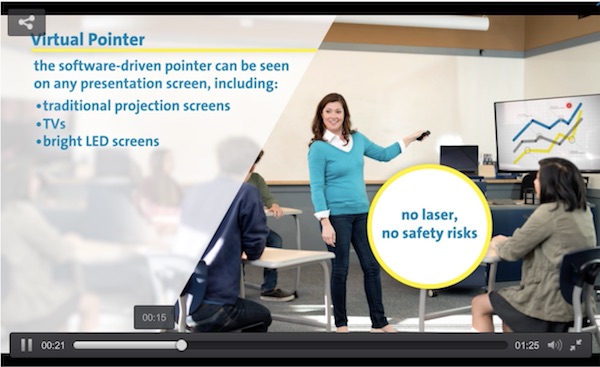
Screenshot from a Kensington video. In the background, the red dot is the software “laser pointer” dot.
Kensington also continues to sell a line of presentation remotes that use red or green laser pointers.
From a September 26 2017 Kensington press release
US: Mosquito-targeting laser still not ready
How has the “Photonic Fence” device progressed? The short answer is that it is still being developed. It is just about to have its first excursion outside the lab.
In a 2,500-word article in the July 24 2017 New York Magazine entitled “Where’s Our Laser-Shooting Mosquito Death Machine?” writer Carl Swanson looked into the Photonic Fence progress.
Swanson visited Myhrvold’s company Intellectual Ventures. He watched a demonstration which he says “is, as you might expect, enormously satisfying. There is the laser itself, aimed by a mirror that is synced to a camera that identifies the pest marked for death based on its shape and size and the distinctive beat of its wing, and a monitor that allows you to watch its autonomous targeting. And it does so fast: 100 milliseconds is the time allotted to see the bug and shoot it for the 25 milliseconds it takes to kill it.” He said the system has killed more than 10,000 mosquitos in the lab.
But the mosquito-targeting system is still in the testing phase. Swanson notes “It’s taken years of development to figure out how to continuously track and identify a specific type of insect and then dispatch it safely and efficiently.”
Eye safety for humans is one consideration: “For instance, for the demonstration, I had to wear protective goggles since that type of laser is not safe for your eyes; I was assured that when it’s market-ready, the laser they deploy will not potentially blind human passersby.”
A major barrier is cost: “And no one has yet worked out how to make the device cheap enough to be useful in the places it is most needed, places where most people’s mosquito-defense system consists of sleeping under nets every night.”
The system “will finally be tested later this summer in Florida, in a screened-in structure, against the Asian citrus psyllid, an invasive bug that is devastating the state’s orchards.” If that goes well, it will then be tested in the open.
From New York Magazine
UK: Man uses laser pointer to "improve" Mars' atmosphere so he can claim it as his own
Dr. Philip Davies does not think he will substantially cause a greenhouse effect on Mars. His effort is primarily to point out shortcomings in the wording of the treaty, that in turn could lead to revisions. Davies' goal is to prevent militarization of Mars or other off-Earth bodies.
To help publicize his effort, he is claiming he owns Mars and is selling plots of Martian land, with a few acres going for one U.S. cent.
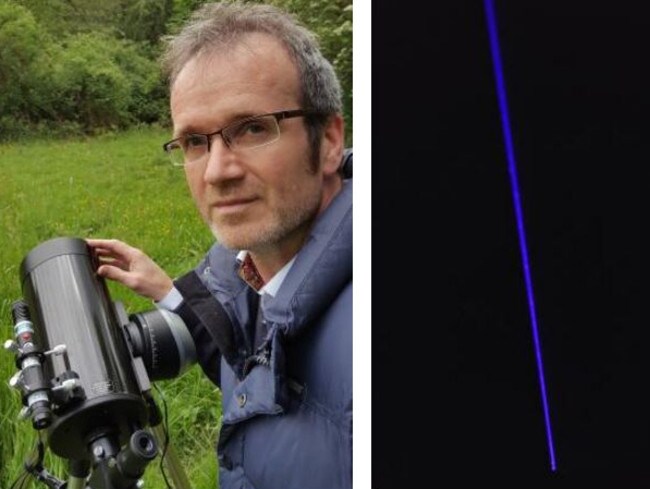
The laser pointer can be seen on the left side of Dr. Davies' telescope. At right is the beam it projects into the sky. From the look of the laser, it's output power is probably in the low Class 4 range, around 500 to 1000 milliwatts (1/2 to 1 watt).
From News.com.au. Davies' efforts have been the subject of numerous news stories such as from the Daily Mail. Do an internet search for "Philip Davies laser Mars" to find the latest on his efforts.
US: Amazon aggressively lowers pricing on Star Shower home laser projectors
A December 14 2016 article in the Wall Street Journal describes a price war between sellers of the updated Star Shower Motion, which adds movement to the laser dots.
The list price from Telebrands was $49.99. It appears they lowered the price to around $35, then Amazon and other retailers lowered their prices to $31-33. The wholesale price of the Star Shower Motion is around $30, meaning that Amazon is barely making money on selling this laser projector.
For consumers this may be good news. However, Telebrands is watching a major distributor undercut its own pricing. And, the lower prices are putting more laser projectors in the hands of consumers.
From the Wall Street Journal (subscription required). Summary at Consumerist. LaserPointerSafety has run previous stories about he Star Shower, since they first became popular in 2015. Click for stories about aviation incidents and for general stories about the lights and their potential hazards.
US: FAA Eastern Region warns against holiday & Christmas laser light display misuse
The full text of the statement is as follows:
“The FAA’s concern is that lasers -- regardless of the source -- not be aimed at aircraft where the beams can threaten the safety of a flight. Consumers who buy laser light displays should take precautions to make sure that the lights are hitting their houses and not shining off into the sky. In situations such as this, we would start by asking the person to either adjust them or turn them off. For more information on lasers, please go to www.faa.gov/about/initiatives/lasers/“
From an FAA Eastern Division email to LaserPointerSafety.com, and from the Boston Globe. LaserPointerSafety has run previous stories about Christmas and holiday laser lights such as the Star Shower, since they first became popular in 2015. Click for stories about aviation incidents and for general stories about the lights and their potential hazards.
US: Laser-emitting binoculars being sold for "night vision"
The Cassini K-9 “Day and Night Vision Binoculars” are normal magnifying binoculars (for day vision) with a green laser light added between the lenses to illuminate objects for “night vision.” Holding down a button activates a 532 nanometer laser, said to be less than 5 milliwatts, with a spot diameter of 4 meters at a distance of 50 meters.
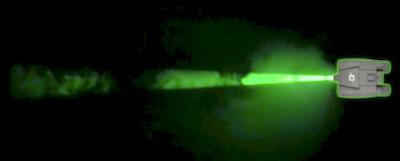
Looking through standard night vision devices, the user typically sees a green glow from the image intensifier that allows enhanced vision in the dark, without any visible light being added to the scene. In contrast, the Cassini K-9 emits very visible green laser light, simulating the look of a night vision device without requiring any other change to the binoculars.
The product manual warns “Please note the green laser is a device and can be harmful if used improperly, and laser radiation can be harmful to the eyes. Do not look directly into the laser beam output aperture during operation. Laser light when reflected off a mirror like surface can cause serious damage and injury. Since the Laser binocular is not a toy, please keep out of reach of children.”
The manual also includes this cautionary graphic:
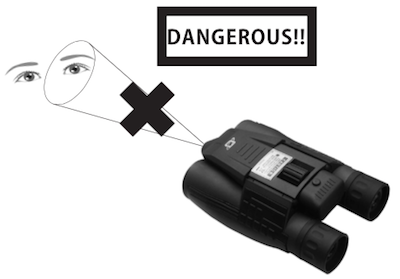
Representative prices range from $94 (Amazon) to $160 (Sharper Image). At Amazon, the product has 3.5 out of 5 stars from 13 reviewers. Amazon reviewer comments include:
- “Didn't realize it would have the bright beam of green light...Very grainy, hard to make thing out….”
- “If you are looking for something to view the dark, without being detected, this is not the one. The green laser is visible!! That's, like you can see it in the dark! The range is not up to par. The beam is cone shaped and is approximately 2 feet wide at 7 yards, carry that out to 100 yards, my scope works better at night with my mag-light.”
- “Much better than reviews indicated. Not for tactical use but adequate for bird watching or varmint spotting.”
From Amazon.com and Sharper Image
Canada: Students developing laser scarecrow to keep geese from crops
The group’s research found that green lasers, even at low power levels, scare geese at night when they are roosting in fields, eating the green shoots of crops such as wheat and barley. They can do “significant damage,” Rashleigh said.
There is a solution during the daytime involving noise from pyrotechnics, but this can’t be used at night in a residential area.
For nighttime geese deterrence, the students looked at other options and concluded that using lasers was the best way to solve the problem. They developed a device placed about 12-15 feet off the ground, installed in the center of the field. It moves the laser across an area, throughout the night. So far, it appears to be “fairly effective.” Response has been “quite positive” from other farmers.
Rashleigh told CBC News that “safety is a huge concern.” The laser only shines where it is intended, in the field. The beam is less powerful than most handheld laser pointers; a person would have to stare into the beams for “about 8 seconds” to have any risk of damage. To protect aircraft, the device can detect if it is being pointed above the horizon, and can shut itself off.
From CBC News, via Forbes
US: Coast Guard seeks FDA waiver; wants to use laser illuminators on helicopters
Currently, the U.S. Department of Defense is permitted to self-certify their laser equipment and usage. The DoD’s Army, Air Force and Navy agencies do not need FDA approval of their helicopter-based laser illuminators. However, the Coast Guard is part of the Department of Homeland Security, which does not have a self-certification waiver. The Coast Guard must currently apply for FDA approval.
On April 14 2016, Rep. Duncan Hunter sent a letter to FDA, asking that the Coast Guard be permitted to self-certify their laser systems. Hunter called FDA’s policy “onerous and burdensome”.
One issue may be that the helicopter-based video system already has low-light and infrared capabilities. Although the laser illumination can further enhance the image, it may not be considered a necessity for operations.
From Seapower magazine
US: Scientist uses "laser-pointer-in-a-can" to discover dinosaur eyes, feathers
In a social media post around late March 2016, Kaye posted photos of a dinosaur’s eye that is only visible with his technique.

A science story notes that Kaye is “maybe the only person on Earth not named Sam Neill who can say he’s looked into the eyes of a pterosaur.”
In previous studies he used green (532 nm), blue (457 nm) and violet (407 nm) laser modules with powers from 150 to 500 milliwatts. This provides much brighter illumination of the subject. For example, a standard 20 watt ultraviolet fluorescent lamp has an irradiance (power over a given area) of 510 milliwatts per square centimeter. A 500 milliwatt (1/2 watt) laser, by comparison, provides an irradiance of around 4000 to 8000 milliwatts per square centimeter.
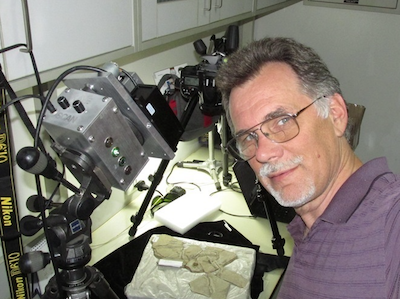
Kaye with his laser apparatus
The story “What Did Dinosaurs Look Like? Tom Kaye Finds Answers, Feathers With Lasers” appeared online at Inverse.com on April 19 2016. Inverse also featured a previous story, “Lasers Can Tell Us More About Fossils Than Before” on October 8 2015. A May 27 2015 paper by Kaye and associates, written for the online journal PLOS ONE, “Laser-Stimulated Fluorescence in Paleontology”, is here.
US: UPDATED - "Star Shower" home laser projector raises aviation concerns
Between November 18 and December 6 2015, there have been at least three incidents, involving six aircraft, where pilots were illuminated with light from “Star Shower” laser projectors. In all cases, the illumination appeared to be inadvertent. The devices were being used for holiday decorating, and stray beams went into airspace. (E.g., a person was not knowingly aiming the Star Shower at an aircraft, or the flight path of an aircraft.)
The Star Shower emits “thousands” of laser beams from two sources, one green and one red. A homeowner can simply aim the Star Shower at her house or foliage, and instantly cover it with green, or green plus red, laser dots.
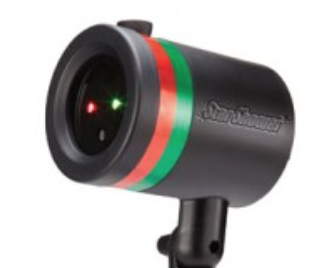
The projector head. It screws into a stake that is placed in the ground for outdoor use.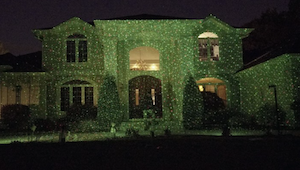
A home densely covered with laser “stars” from multiple Star Shower projectors. Both photos from the Star Shower website.
According to a comprehensive story in Inquisitr, Star Shower is so popular that it is sold out in many locations. TravelPulse calls it a “laser cannon.”
The Federal Aviation Administration on December 8 2015 tweeted “Decorating for the holidays? A stray laser could blind a pilot.” They then provided a link to general information about laser/aviation safety. An FAA spokesperson told CBS Philly, ““I don’t think anybody who buys these devices even think they have enough power to hit an aircraft in the sky…. If the box is aimed a little high, some of the lasers will not hit the roof of the house, they’ll keep going into space.”
While there is no warning on the outer packaging, the Star Shower instruction sheet says: “NOTICE: Lasers should not be projected at or within the flight path of an aircraft within 10 nautical miles [11.5 miles] of an airport. If your intended surface is within 10 nautical miles of an airport, lower the angle of the Star Shower so that no lasers point into the sky.”
In a December 9 2015 statement to NBC Los Angeles, the manufacturer added: “Star Shower Laser Lights operate by taking a single laser beam and diffracting it into thousands of individual laser beams. Each beam emitted by Star Shower is much lower in power than a typical laser pointer. Each individual laser beam is 10 times less than the maximum permissible exposure (MPE) allowed by the FAA normal flight zone (NFZ) criteria.”
In an urban or suburban environment, it is likely that most homes are within 10 NM of some type of airport. It may not be a major metropolitan airport; it could be a small general aviation facility. In a December 3 2015 incident, a Boeing 737 at 13,000 feet and 22 miles east of Dallas-Fort Worth Airport, reported seeing lights from what was believed to be a “laser holiday light display.”
From the FAA, Inquisitr, NBC Los Angeles
Analysis and commentary by LaserPointerSafety.com
ADVICE FOR OUTDOOR USE
After purchasing and testing a Star Shower, here is our summary advice for consumers. Details then follow.
The Star Shower is essentially eye-safe, and does not cause direct interference (glare) with pilots’ vision after about 411 feet. However, a single beamlet can be a distraction to pilots at least 3/4 of a mile away, and possibly further away due to the large number of laser dots aimed into the sky causing a flashing effect.
For this reason, a Star Shower needs to be aimed so that beams don’t go into airspace. You do not want an officer knocking on your door because a pilot saw and reported your home laser projector. While it is unlikely you would be arrested for an unknowing aircraft illumination, federal penalties for laser pointer misuse range up to five years in prison and up to a $250,000 fine.
Putting the projector closer to a house will keep more of the beams on the structure. Similarly, don’t aim it up into a tree unless the tree is very dense, such as an evergreen.
It should also be noted that there are reports such as this and this of Star Showers being stolen from yards. If you put your projector on a roof or up in a tree, aiming downwards, this both helps aviation (no beams going up into the air) and makes it harder to steal the projector. Finally, if you are in a heavy air traffic area, you might want to consider restricting it to indoor use only.
IS A STAR SHOWER LEGAL?
Under U.S. federal law, the Star Shower is legal to own and operate. As a Class IIIa (3R) laser, there are no federal restrictions on its use. The federal law prohibiting laser pointer misuse may not apply, for two reasons. 1) It prohibits knowingly aiming at an aircraft or its flight path, and 2) the law applies to “laser pointers…designed to be used by the operator as a pointer or highlighter….” This definition would not seem to apply to a device that is not a pointer, and is not used “…to indicate, mark, or identify a specific position, place, item, or object.”
A few states or localities may have restrictions on lasers that would affect Star Shower. Since it is not a laser pointer, and is not used for pointing, restrictions that cover laser pointers may not apply (depending on the exact definition). Some selected state and local laws are here.
Common sense says that a person should not stare into the beams, and that they should not be aimed to harass others. Similarly, the beams should not be aimed down a road or up into the sky, where they could interfere with drivers or pilots.
PURCHASING AND PACKAGING
In early December 2015, we purchased a Star Shower for $40 from a CVS drugstore. The box lists a sales website at BulbHead.com, and the distributor as Telebrands. It also says “Made in China.”
Both the box and the device have the proper FDA-mandated laser safety labeling. The device is FDA Class IIIa, meaning less than 5 milliwatts output. There are two apertures, one for 532 nm green laser beams and one for 650 nm red beams. A diffraction grating in front of each laser breaks the single beam into dozens or “thousands” of less-powerful beamlets. In a foggy or smoky environment, it is possible to see the beamlets in the air, but they are too weak to be seen in clear air.
Although the Star Shower has been popular for the Christmas 2015 season, the packaging does not emphasize this. Instead it says the Star Shower is “great for” indoor, landscaping, holiday, winter and summer uses. The advantages are: “No ladders, no hanging, no dead bulbs, no mess — just plug it in.”
TESTING
We took it to laser expert Greg Makhov of Lighting Systems Design Inc. for testing. Keep in mind that he tested just this one sample unit; we assume it is representative of the other Star Showers that have been sold.
Makhov used two different types of power meters, both which could measure in the microwatt and milliwatt region. He found that the maximum power of a single beam was 0.4 milliwatts. The chart below shows details.
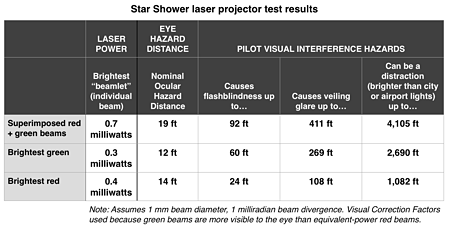
ESSENTIALLY NO EYE INJURY HAZARD
The brightest single beam, at 0.4 mW, is below the 1.0 mW Class II limit. Class II laser pointers are generally considered to be safe for accidental exposure. Eye injury from a Star Shower would be almost impossible unless a person at close range deliberately overcame his aversion to bright light and stared for many seconds into one of the beamlets, keeping it at the same spot in his visual field.
While the chart shows the Nominal Ocular Hazard Distance to be as far as 19 feet, keep in mind this is a “nominal” hazard. This does NOT mean that beams will cause injury at this distance. There is a kind of safety factor built in to the NOHD. A quick approximation is that at about 1/3 the NOHD (about 6 feet in this case), there is a 50-50 chance of a laser kept steady on the eye causing the smallest medically detectable lesion on the retina, under laboratory conditions.
GLARE UP TO 411 FEET, DISTRACTION TO 3/4 MILE
The chart also shows the visual interference hazard distances. For example, a pilot could experience veiling glare (she can’t see past the light) up to 411 feet away from the Star Shower projector. The light does not interfere with vision, but is a mental distraction, up to 4,105 feet away — a little over three quarters of a mile.
The above eye and visual interference calculations are for a single beamlet, for two reasons. First, at aviation distances, only one beamlet would enter the eye at a time. They are not so close together that two separate beamlets of the same color would be within one pupil diameter. The second reason is that even a person is so close to the Star Shower that two separate beamlets enter his pupil, each one will be focused onto a different area of the retina. This means that the beams don’t overlap — they are heating different areas. This is why we are primarily concerned — both for eye safety and for aviation interference — with the hazard of a single beamlet.
Now, when a helicopter flies through the dozens or “thousands” of laser beams, this can be more distracting than a single beam. It is no wonder that a pilot might report the laser display, and have it re-aimed or shut down.
Although an FAA spokesperson said a Star Shower was reported by a pilot who was at 15,000 feet, at this distance any single beamlet would be far below the FAA’s distraction limit. This means any beamlet would be no brighter than surrounding city or airport lights. It could be that the large number of beamlets caused flashes as the aircraft flew through them, and that this flashing was itself a distraction. Either way, no competent pilot at 15,000 feet should have any visual interference from a Star Shower. The only problem could be mental distraction, if the pilot paid more attention to the light than to flying the aircraft.
DISASSEMBLY AND HACKING (UPDATED DECEMBER 2016)
In early December 2016, Julius R. wrote to us wondering about the safety implications of opening the Star Shower and removing the star-creating holographic diffraction grating.
Our Star Shower, purchased in December 2015, has four security screws hidden behind rubber caps. The screws are at the bottom of a 2-1/4” deep shaft that is 5/16” in diameter. The screw head shape is a triangle with a raised dot in the center: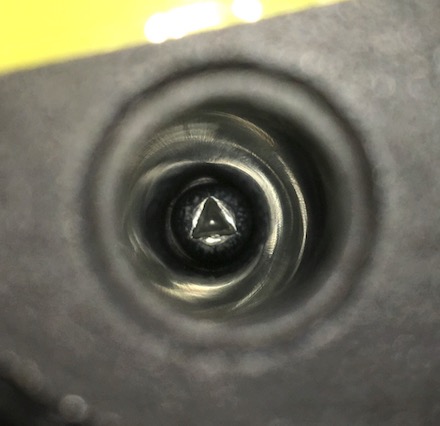
It would require a long screwdriver with a matching tip to reach and undo the screw. A brief search of Google Images to try to find such a screwdriver did not turn up any instances.
Certainly someone might be able to find such a tip, or to grind a shaft to fit. And breaking the Star Shower’s plastic housing could also give access to the inside. So if someone really wanted to get at the interior lasers, it would be possible.
We estimate that each of the lasers on the inside would be in the 10 to 50 milliwatt range. This power can cause an eye injury, although the injury would be relatively minor (assuming an unintentional exposure; deliberate staring into any laser beam should never be done). It is at the low end of Class 3B lasers.
There are similar lasers, and much more powerful ones, readily available online. They would be cost the same or even less, and would be much easier to use. So a laser hobbyist or hacker is unlikely to use a Star Shower as a source for red and green single-beam lasers.
In short, disassembly and misuse of the interior lasers is not a significant safety concern.
FOR FURTHER INFORMATION
Anyone with further questions can contact us; click the link below in the footer at the bottom of the page.
General: How many laser pointers to kill a human?
Author Adam Clark Estes begins with a primer on laser light, and determines that the beams from many lasers would have to be focused on a single spot. Estes quoted Dr. Rebecca Thompson of the American Physical Society:
“…if you wanted to create a death ray with laser pointers, you could buy 200,000 laser pointers [cat-toy type with 5 milliwatt output each], mount them on a piece of a sphere with radius 5.5’, aim them all through a lens and ask your victim to sit very, very still.”
The article concludes “Do not try this at home.”
From Gizmodo. Thanks to Roberta McHatton for bringing this to our attention.
Japan: "Smartglasses" aim laser light directly into eyes
The laser is full color (red, green and blue combined) and is said to be harmless. The system was developed primarily as a vision aid for persons with visual defects. According to the news story, the image does not require focusing and is projected through the eye’s lens directly onto the retina.
The story notes that “the basic idea of projecting imagery onto a retina via laser has been around for decades, but miniaturizing the optics to realize a wearable form factor had been difficult until recently.”
A Fujitsu spinoff called QD Laser helped develop the glasses. They expect to begin selling them in March 2016 in Japan, Europe and the U.S. for about USD $2,000.
From PC World
US: "SteadyLaser" pointer said to reduce hand motion
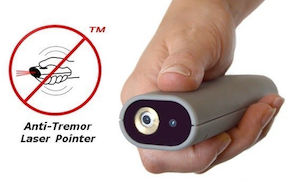
The SteadyLaser
The first version being sold on Kickstarter contains two Class 2 (<1 milliwatt) 635 nanometer red laser modules. The module on the left (in the photo above) is suspended inside the TV-remote sized SteadyLaser. It provides the stabilized beam. The other laser is non-stabilized, like a standard laser pointer. In the final Kickstarter version, the user can choose either either the stabilized beam or the normal beam, but — for safety reasons — not both at once.
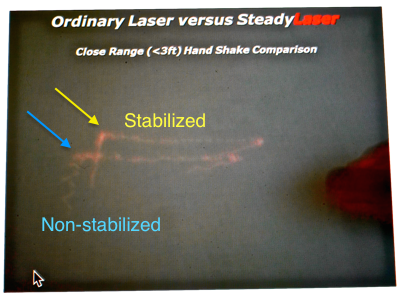
This is a 2-second exposure, from a Kickstarter video, showing both beams being emitted simultaneously in order to demonstrate the stabilization’s effect. The line traced by the stabilized laser is up and to the right of the non-stabilized laser’s line.
Pricing for the initial run of 1000 SteadyLasers is approximately $150 each. It is promoted on Kickstarter solely for presentations in professional locations such as businesses, schools and courts. The primary benefits are claimed to be minimizing distraction, and reducing the appearance of nervousness when using a laser pointer in presentations.
The Kickstarter page first went up approximately April 10 2015. As of April 13 there were 6 backers pledging $960. The goal is to get $150,000 in backing by June 9 2015; otherwise the laser will not become a product — or at least, not through Kickstarter.
Regardless of the Kickstarter outcome, the inventors want to license their patents to current laser pointer manufacturersd.
From SteadyLaser.com, the SteadyLaser Kickstarter page, and Sys-Con Media via PRNewswire
Commentary from LaserPointerSafety.com
There could be concern over a handheld laser that can remain steady on a target. If aimed at an aircraft’s cockpit, the beam would be able to stay in a pilot’s vision longer than a standard, non-stabilized laser pointer.
Because of this potential hazard, LaserPointerSafety.com contacted co-inventor Jeff Wilson, who kindly agreed to add an aviation safety warning to the SteadyLaser’s labeling, with text such as “Do not aim at vehicles or aircraft. This is hazardous and illegal.”
The first-generation SteadyLaser has low power (1 mW) and low apparent brightness (635 nm red, which appears only 25% as bright to the human eye as the common 532 nm green laser). Assuming a 1 milliradian divergence, the SteadyLaser is an eye hazard to 23 feet, can cause flashblindness up to 55 feet from the laser, can cause glare up to 245 feet, and would be a distraction to pilots (brighter than other city and airport lights) up to a half mile from the laser.
However, if future versions had more power — up to the U.S. FDA’s limit of 5 mW for laser pointers — and used a 532 nm green laser, then the hazard distances would increase as follows: eye hazard to 52 feet, flashblindness to 245 feet, glare hazard to 1,097 feet, and distraction hazard to 2.2 miles.
Worldwide: Handheld laser being used by airports to disrupt birds
The Aerolaser is made by the Delft, Netherlands company “Bird Control Group”. The handheld device uses a green laser with a range over 2500 meters (1.6 miles). The company claims that birds do not grow used to the laser, and it is safe for the animals. According to an article at the website IHS Airport360, “As a safety feature, the laser is disabled above a certain height - this prevents the beam from being shone directly at aircraft or controllers in the tower.” In addition, the operator can look through a scope so he or she knows where the beam will be directed.

Conceptual diagram of using a handheld laser around airports, from Aerolaser.com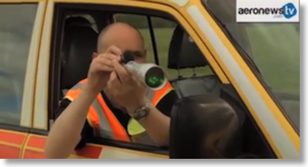
A frame from an Aerolaser video describing use at the Southampton airport.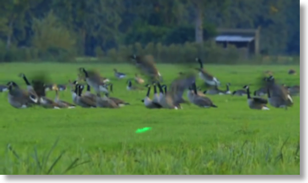
A frame from another Aerolaser video showing laser light scattering birds.
The company also makes an automatic, autonomous system called Aerolaser Groundflex, pictured below from the company’s website:
According to Wikipedia, “bird strikes are a significant threat to flight safety” since 35% of strikes result in damage to the aircraft, costing $400 million per year in the U.S. and up to $1.2 billion per year worldwide.
Bird Control Group also makes the Agrilaser Lite (range of 1000 meters) and the Agrilaser Handheld (range over 2000 meters), intended to keep birds away from fields and crops.
From Aerolaser.com, Agrilaser.com, IHS Airport360, and Wikipedia’s “Bird strike” article
Cambodia: Artist, inspired by Picasso, uses laser pointers to paint with light
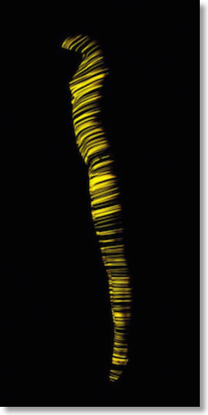
From an exhibition of laser pointer-created light paintings by Gian Claudio di Cecco.
He pointed to Pablo Picasso, who in 1949 collaborated with Life Magazine photographer Cjon Mili to create light drawings:
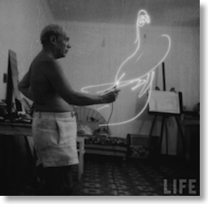
From a series of photos created by Picasso for Life Magazine in 1949
Di Cecco said that using laser pointers was a challenge: “When you open the shutter for 20 seconds, you have to go really fast with the light – it’s like dancing. And sometimes the model moves, and you have to try and try with the same model for the perfect picture.”
From the Phnom Penh Post. Additional photos of Di Cecco’s work can be seen at the link.
Worldwide: Review of laser "stars" projector; question about aircraft interference
The reviewer, Bill Kuch, says the green-only version contains a Class IIIa laser that uses diffractive holographic optics to create the beams. According to the instruction pamphlet, “Each individual laser beam is less than 5 mW, which is about the same as an average laser pointer.”
He then talks about testing the unit indoors and outdoors. Kuch said that after aiming at the tree canopy around his cabin in the woods, his neighbors came out, commented positively, and asked where they could purchase one.
In the final paragraph, he says when he pointed the projector up into the trees, “that begs the question: could it interfere with aircraft flying overhead?”
Review of the Viatek Night Stars Landscape Lighting from the Gadgeteer.
Click to read more...
US: No laser beam headlights for U.S. cars -- not without rule changes
Toyota has filed a petition with the National Highway Traffic Safety Administration, seeking to allow the advanced headlights.
A story in Ars Technica goes into more detail about how the laser headlights work, and how companies are advocating for “sensible policy solutions where the tech and car worlds intersect.”
From a June 5 2014 Ars Technica article by Jonathan M. Gitlin
Note from LaserPointerSafety.com: Although automobile headlights are not laser pointers, they do use diodes similar or identical to those in high-powered blue lasers such as the multi-watt Wicked Lasers S3 Arctic handheld. In headlights, laser diodes are used to energize a phosphor coating so that incoherent bright white light is emitted. The small diodes allow the headlight assembly to be lower-profile, giving more flexibility in body design and aerodynamics. They also allow beam shaping to avoiding dazzling other drivers, and aiming the beam in the direction of travel while turning. Our coverage of laser headlights (other stories) can be found here.
US: Lockheed Martin demos laser that can burn holes in rubber boats from a mile away
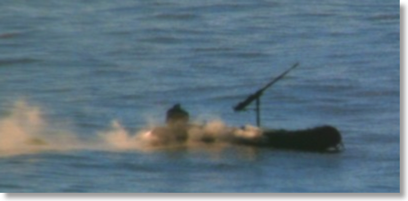
A YouTube video shows infrared and visible footage of the test.
The 10-kilowatt High Energy Laser (HEL) system previously demonstrated an ability to track, target and destroy rockets traveling at high speed.
From Gizmag and Engadget
Israel: Lasers on airplanes used to deflect missiles
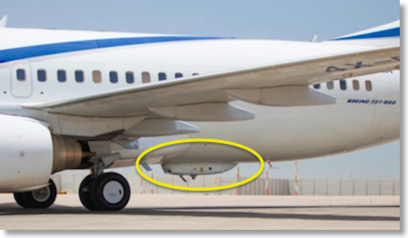
The C-MUSIC system mounted on a Boeing 737-800
The system was developed after a 2002 incident in Kenya where terrorists fired two surface-to-air missiles at an Israeli charter plane carrying more than 250 passengers; the missiles missed their target. C-MUSIC will be added to all El Al aircraft. In addition, the developer Elbit Systems has contracts with other countries besides Israel.
From Wired via Ubergizmo
US: Famous DJ explains why he had to have a 2 watt laser pointer
Avicii answered “I just bought a really awesome laser pointer. It's two watts, so it's five hundred times stronger than those regular green laser pointers. If you were standing on top of the Empire State Building with it, you could see all the way to Philadelphia. It's dangerous. You can't really play with it. You need to use goggles or you could go blind. But I saw some YouTube videos where it set stuff on fire, and I was like yes. It cost $1,500. That's not too bad for such an amazing invention.”
From Rolling Stone
Scotland: Concern over using laser pens to banish pigeons from Parliament building
Hawks were originally used to scare pigeons away from the modern building, opened in 2004. When these proved unsuccessful, contractors turned to the laser pens. They are primarily used at dawn and dusk to disturb and disperse roosting pigeons.
A spokesperson for the Pigeon Control Advisory Service said “Laser pens can be lethal and blind animals and birds. They are definitely not something we would ever recommend.” PETA, People for the Ethical Treatment of Animals, also said the animals eyes could be damaged and that other humane, non-harmful methods should be used.
From the Edinburgh News, Jan. 23 2014. Thanks to Paul Bluesky for bringing this to our attention.
UPDATED Jan. 27 2014: The contractors said they must abandon the “no kill” policy in order to further reduce the pigeon population on the Scottish Parliament building. A Parliament spokesperson said there had been no change of policy. From the Edinburgh News
Worldwide: Audi introduces laser headlights; follows BMW's lead

Audi Sport Quattro concept car
BMW also has introduced laser headlights, on its electric supercar i8.
The headlights use laser diodes to energize a phosphor that creates white light. According to Audi, the beams have a range of 1640 feet, twice the distance of LED high beams.
Technically, the white-light beam would not have the same coherence as a laser, making it safer for human vision (at least, at normal driving distances -- any very bright light viewed up close could be an eye hazard). An Audi spokesperson said “Our main aim was to not dazzle any drivers, laser technology is much more accurate.”
Because the laser diodes are so tiny -- only a few micrometers in diameter -- the headlight assembly itself can be made smaller as well.
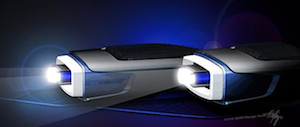
Closeup of the Audi laser headlights
The laser power appears to be about 10 watts, based on an Australian report that “the system is 10,000 times more powerful than a laser pointer”. Such pointers in Australia are limited to 1 milliwatt or 1/1000 watt. It is unclear if this refers to the total power of both headlights, or of a single headlight.
From Car and Driver, and News.com.au. MotorTrend has an excellent article from 2011 describing in detail how the BMW laser headlights work. It contains an account where journalists looked directly into the light without adverse effect.
US: Time-lapse video shows astronomy lasers being used at Mauna Kea
Sean Goebel, a graduate student in astrophysics, has produced a 3-minute time-lapse video showing observatories at Mauna Kea, Hawaii, shooting lasers into the night sky. By analyzing how the beam is distorted by the atmosphere, a telescope’s mirror can be counter-distorted in order to obtain sharper images for astronomers.
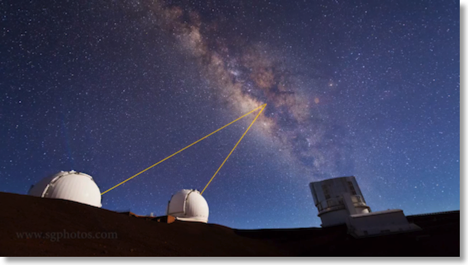
A still frame from the video. Two telescopes are simultaneously observing the same spot in the Milky Way, using lasers to help give a sharper image.
Goebel writes about the lasers:
“A typical laser pointer that you might use to point at stuff/exercise your cat is about 5 mW. That's five one-thousandths of a watt. Not a whole lot of power. And yet it's enough to blind airplane pilots. The lasers on the telescopes are in the range of 15-40 watts. The FAA calls a no-fly zone over the area when a laser is in use, and two people have to stand around outside in the freezing temperatures and watch for airplanes. Each of them has a kill switch to turn off the laser in case an airplane comes near.”
“Additionally, the telescope has to send its target list to Space Command ahead of time. Space Command then tells them not to use the laser at specific times, ostensibly to avoid blinding spy satellites. However, you could calculate the spy satellite orbits if you knew where they were at specific times, so Space Command also tells the telescope to not use the laser at random times when no satellites are overhead.”
To clarify, the FAA does not have a no-fly zone, but instead issues a “Notice to Airmen” or NOTAM about the laser operations. It is not illegal to fly over the area. Fortunately, at Mauna Kea’s location and altitude only a couple of flights per month fly at night within the laser-affected airspace over the mountain. At one telescope, planes get close enough to the beam to cause a shutoff once every year or twin.
Automated aircraft-detection systems are slowly being tested and phased in, since the cost of having humans watch the skies all night at Mauna Kea’s altitude (13,700 feet) is about $600,000 per year.
The video, “Mauna Kea Heavens”, can be seen at Sean Goebel’s website, which also has more information about adaptive optics lasers and how the video was made. Additional information on aircraft frequency and spotting techniques is courtesy Paul Stomski of the Keck Observatory. A story about Keck’s aircraft protection system appears online in Ascend magazine.
US: Toy helicopter powered by 500-watt laser beam; kept aloft for more than a day
They noted that the technique could be scaled up to create laser-powered drones that could do useful work: “commercial laser-powered flight applications are only a few years away.”
Click to read more...
UK: Handheld (industrial) laser easily cuts through metal
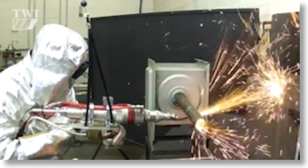
The device came to public attention September 28 2013 when gadget blog Gizmodo published an article entitled Holy Crap, This Real-Life Laser Rifle Cuts Through Metal Like Nothing. The article links to TWI’s YouTube video of the laser in action.
US: Laser aimed from aircraft to ground results in dozens of calls
In a September 16 2013 article, HawaiiNewsNow said there were “dozens” of inquiries about the nighttime green light. One person emailed that the aircraft circled his area about six times at 1:00 am, with a wide green laser that appeared to be scanning downward. Another email confirmed the multiple passes with a V-shaped green laser.
The Army Corps of Engineers is conducting the work. They stated that the laser is not harmful to the eyes. The Oahu work should take about a week, and mapping the entire state should conclude in November.
From HawaiiNewsNow. Similar flyovers using visible green lasers have occurred in other U.S. cities, such as New York City in 2010 and 2012, according to a a brief Google search of such reports, for example here and the comments here.
UK: "Blaze" bike light uses laser to caution motorists during night rides
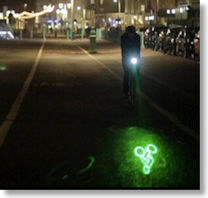
The laser-projected image appears to be formed by a holographic diffraction grating, similar to those used in “caps” on laser pointers to make simple logos such as faces, dollar signs and other graphics:

Blaze’s inventor, Emily Brooke, put the product on Kickstarter in November 2013 and reached its funding goal within 27 days. The initial cost of a Blaze is £60 (USD $96).
A description at Kickstarter states that when Blaze is off of its bracket on the bicycle, the laser cannot be turned on, as a safety measure. The internal laser will be a “more powerful module than you’d typically find in a laser pointer”. However, because the beam is spread out by the optical element, it will be a Class 2 laser product with human access safety equivalent to a laser pointer that is less than 1 milliwatt.
She also notes that the laser is aimed down onto the road so it will not dazzle drivers.
From CNN
UPDATED -- October 27 2014: Blaze is out of Kickstarter and is a product. The new website is at Blaze.cc. According to the website, as of October 2014 the company has sold 3,000 Blaze laser bike lights. The final cost is $200, shipped anywhere worldwide. The laser is a direct-diode green laser, not a DPSS. It is said to be “retina safe.”
Belgium: Art installation uses laser pointers to trigger visuals, play music in a church
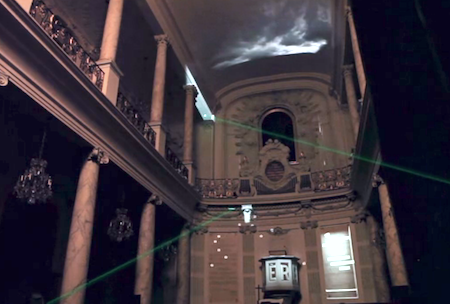
The laser pointer coming from lower left leaves a trail of falling “stars,” while the laser coming from the right triggers a glow on a ceiling beam plus a video to play on the ceiling.
The installation, Archifon II, was created by artists Tomáš Dvorák and Dan Gregor.
From Archifon, which has an embedded video of the installation shown above, Archifon II, as well as the first Archifon.
South Africa: Laser pointer strapped to archer's head, to improve shooting accuracy
From the Council for Scientific and Industrial Research
US: Amateur astronomers illuminate International Space Station with spotlights and 1-watt laser
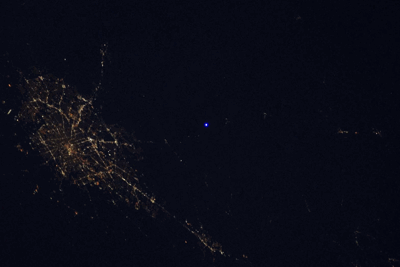
Two-frame animated GIF showing bright and dim light from the Lozano Observatory (center) near the city of San Antonio (left). North is to the right in this photo from the International Space Station, taken by astronaut Don Pettit. Click on photo for a larger version.
The spotlights were flashed at the ISS by holding plywood sheets in front of the lights every two seconds. This procedure can be seen in the video below.
The animated GIF above shows a bright blue light alternating with a dim light. The bright light is almost certainly from the spotlights. The bluish tint may be an artifact of oversaturating the camera’s sensor. Astronaut Don Pettit reported that the bright light appeared white, and the dim light appeared blue. He wrote “We could only see the laser when the white light was off and not all the time.” (E.g., the white spotlights overpowered the blue laser.) He added, “It was like there were tracking issues with the laser to keep it on target.”
The dim light in the animated GIF may be the laser only, or it may be light from the spotlights that wasn’t fully blocked by the plywood sheets. The astronomers will be working with Pettit, trying to pin down exactly how visible the laser light was.
General interest: Article discusses pros and cons of laser sights for weapons
Author John Wills notes that laser sights are not as effective beyond 20 feet, and they do not substitute for marksmanship techniques such as grip and stance.
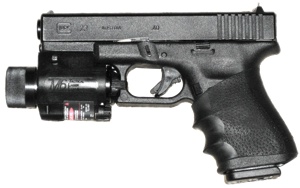
Glock Model 23 with M6 Tactical Laser Illuminator (xenon light plus red laser pointer < 5 mW).
Image from nukeit1 at Flickr, CC by 2.0 license.
Green laser sights are now available; they are more easily seen than an equivalent-power red laser. Infrared laser sights are made for use with night vision goggles. The beam cannot be seen by the naked eye, so a bad guy does not even know he is being targeted.
Wills concludes by saying “like any other tool there is a right way and a wrong way to use” lasers.
From Officer.com
US: First laser dazzler FDA-approved for non-military police

Range diagram from a PDF product brochure for the GLARE Enforcer laser dazzler
While the nominal ocular hazard zone (NOHD) at full power is 130 feet, the device includes a safe, low-power laser that measures the distance to a person or reflective object, and lowers the light level so it is safe at the detected distance. Military dazzlers do not have such a feature, relying instead on training soldiers not to aim the laser at persons closer than the hazard distance.
Laser journalist Jeff Hecht reported in a February 13 2012 article that there have been “some injuries” from military dazzlers, most of them minor. He also noted that ordinary citizens armed with laser pointers could be more of a hazard than police or military dazzlers. For example, lasers were used against police in Greece during riots in June 2011.
From New Scientist. The B.E. Meyers Electro-Optics GLARE Enforcer product page is here.
US: Military aircrews can use finger-mounted laser pointers for target identification
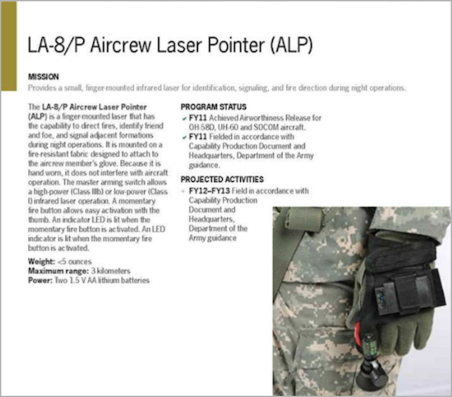
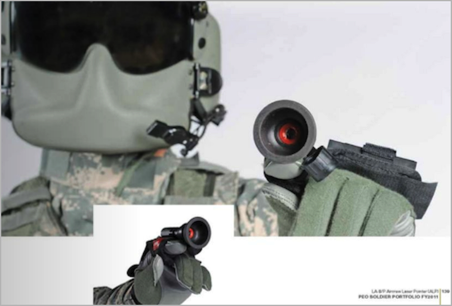
For the military laser enthusiast, the catalog contains a number of other laser devices such as the AN/PEQ-14 Integrated Laser White Light Pointer (actually a white flashlight plus a visible and an invisible laser):
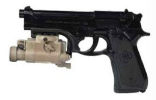
From the Program Executive Officer Soldier Portfolio FY2012 catalog. The LA-8/P is on printed pages 138-139, electronic pages 146-147. Originally found via GovWin.
Commentary from LaserPointerSafety.com: Although the LA-8/P Aircrew Laser Pointer does not emit a visible beam, it would be easy to make a visible version so that aircrews could “fire back” at persons on the ground aiming laser pointers at them. Whether this is a wise idea is another matter.
.
World: Laser pointer focus/aiming aid for cameras
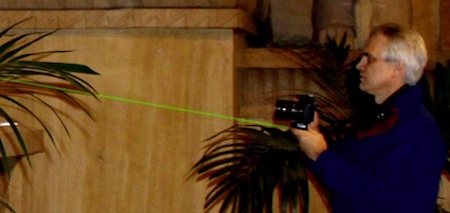
A promotional photo demonstrating the concept of the PinPoint Focus Assist
The manufacturer says the PinPoint complies with U.S. FDA safety regulations. It is said to be a Class 2 green DPSS diode with output power less than 1 milliwatt. The focus range is from 2.5ft/7.5m to 131ft/40m; the aiming range is 700ft/210m in low-light and “further in darkness”.
At their website, DeluxGear has an admirable list of safety warnings which include:
- Don’t aim at a person’s eyes. This can cause “temporary vision dysfunction such as flash blindness, disorientation or glare. This can be particularly dangerous if the exposed person is engaged in a vision-critical activity such as driving or other means of transportation.”
- Don’t aim it at a person without notifying them in advance.
- Don’t aim at a law enforcement officer as this is illegal in many jurisdictions.
- Never aim at vehicles including aircraft.
- Don’t allow a minor to use unsupervised. In some jurisdictions it is illegal for a minor to purchase or use a laser product
Incidentally, the beam on/off function is separate from the camera. This means the beam does NOT come on when the shutter button is pressed, but instead is controlled by a separate switch on the PinPoint.
From DeluxGear; click on the “Protect Your Gear” menu to read the list of safety warnings.
.
Germany: BMW shows safety features of its new laser headlights
Each of the four headlights uses three blue lasers. The lasers are directed by mirrors onto a lens containing yellow phosphorus. This re-emits white light onto a larger mirror that reflects it out the headlight glass onto the road.
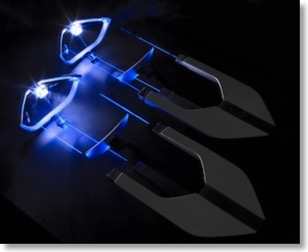
Two of the four laser headlights are shown here. The resulting white light beam is emitted toward the upper left of the photo.
The system is 1000 times brighter than LED headlights, uses half the power, lasts just as long (10,000 hours) and allows more flexible designs. BMW noted that light emitted from the headlights is not laser light, and is safe to stare into. In case of an accident, the headlights are powered down so no laser light could escape.
[Note from LaserPointerSafety.com: It is likely that the laser diodes in the headlight are the same type used in Casio’s Green Slim projectors and the Wicked Laser Spyder III Arctic handheld laser. These are relatively inexpensive -- less than $30 each in quantity -- and produce a nominal 1 watt of light.]
From Motor Trend
US: Pentagon delayed using laser dazzers in Iraq
During the U.S. phase of the Iraq war, Marine Corps leaders requested the handheld devices as a way to warn and stop drivers who were overrunning military checkpoints. Wired’s David Axe estimates that “as many as 50” Iraqi civilians were killed by gunfire -- instead of being forced off the road by dazzlers -- during the nine month delay.
There is some dispute over the safety of laser dazzlers. According to the Inspector General’s report,
Laser dazzlers provide a nonlethal capability by emitting an intense light capable of temporarily obscuring the vision of approaching individuals; however, using lasers poses a risk of serious eye injury and permanent blindness. This mode of employing a laser, shining a laser directly into the face or eyes, increases the inherent dangers of using the laser. Using nonlethal laser dazzlers would give Marine operating forces an additional capability to increase stand-off distances, safeguard civilians who venture too close to Marine positions, and help prevent unwarranted escalation of force incidences; however, DoD [Department of Defense] policy prohibits the use of lasers designed to cause permanent blindness. Operating procedures and laser safety measures are essential to ensure the safe and proper use of the lasers.
The Inspector General’s report contains additional details about the range, capabilities, safety concerns and policy issues related to military use of laser dazzlers. For example, the 1995 Protocol on Blinding Laser Weapons states that the signatories (which include the U.S.) “shall take all feasible precautions to avoid the incidence of permanent blindness to unenhanced vision.”
From Wired.com.
UK: Laser "dazzler" from BAE Systems for use against pirates and other threats
Roy Clarke, BAE Systems capability technology lead for laser photonic systems, said: “The effect is similar to when a fighter pilot attacks from the direction of the sun. The glare from the laser is intense enough to make it impossible to aim weapons like AK47s or RPGs, but doesn’t have a permanent effect.”
From the BAE Systems press release.
US: Police considering laser dazzlers to "blind" suspects
US: Lasers being used to burn string in arcade games (to get prizes to drop)
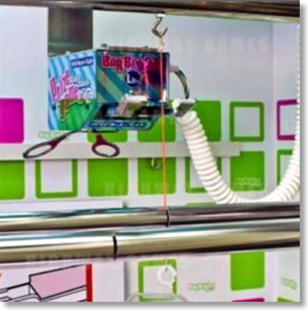
Namco America sent the notice to arcade operators of BarBerCut Lite and other hanging prize type games in May 2010, after powerful handheld laser pointers became available online at relatively low cost. Namco noted that “a criminal armed with one of these can steal a number of prizes from a merchandiser in a short period of time.”
White cords and zip ties are recommended, since they reflect most of the laser’s power. In 2009, Namco changed from black and colored fasteners, which absorb the laser’s light.
From Vending Times
